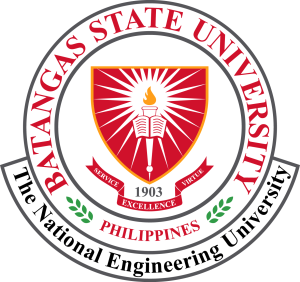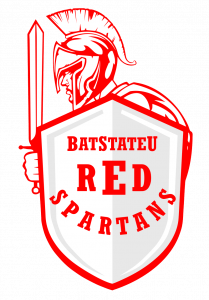Data Management

HOME REGISTER 23 HOURS ONLINE ENGLISH 20 HOURS HYBRID ENGLISH HOME REGISTER In this course, you will learn the basics of data concepts and how to use Microsoft Azure’s data services to manage them effectively. We will cover everything from relational and non-relational data, to big data and analytics, giving you a robust understanding of cloud data services available on Microsoft Azure. The course will guide you through the fundamentals of relational data and the database services offered by Azure. You’ll get to know how to work with non-relational data using Azure storage solutions and will be introduced to the capabilities of Azure Cosmos DB. Plus, we’ll shed light on large-scale data warehousing and how to make the most of real-time analytics and data visualization. This course is ideal for those who are looking to grasp database concepts in a cloud setting, and to gain a solid foundation in Microsoft Azure’s data services, whether you’re brushing up on basics or learning it all for the first time. What You’ll Learn At the end of this course, learners will be able to describe data concepts, roles, and services. They will also be adept at evaluating relational database service and non-relational data on Azure. Additionally, learners will be skilled in managing data analytics and visualization on Azure. Skills You’ll Gain Data Science Cloud Infrastructure Management Roles Database Administrator What You’ll Learn At the end of this course, learners will be able to describe data concepts, roles, and services. They will also be adept at evaluating relational database service and non-relational data on Azure. Additionally, learners will be skilled in managing data analytics and visualization on Azure. Skills You’ll Gain Data Science Cloud Infrastructure Management Roles Database Administrator Course Outline Module 1: Cloud Concepts Module 2: Azure Architecture and Services Module 3: Azure Management and Governance Module 4: Data Concepts Module 5: Relational Data Module 6: Non-relational Data Module 7: Data Analytics in Azure Reqired Resources Laptop, Intel Core i5 or higher, 16GB RAM, 1TB Storage, Graphics Card (Hardware); Microsoft Azure (Software); Adequate Internet Connection (Network) Pre-Requisites None Assessment In this Data Management course: One (1) diagnostic assessment is available, conducted synchronously and based on knowledge, with the flexibility for learners to choose between remote or on-site participation. Two (2) formative assessments are offered, one focusing on knowledge and the other on performance. Both are available asynchronously, allowing learners to complete them at their own pace, with the option for remote or on-site participation. A knowledge-based style summative assessment is scheduled to be conducted synchronously, providing learners with the choice of participating remotely or on-site. Credit and Recognition The learner is eligible to take the Microsoft Certified: Azure Fundamentals and Azure Data Fundamentals. This course is facilitated by a Microsoft Certified professional. To ensure the quality of this micro-credential, continuous feedback loops with students, instructors, and industry practitioners are maintained to continually improve content, delivery, and assessment methods. Learning Pathways Data Management is the foundational course for your journey in the world of data. Upon successful completion, you’ll have the choice to specialize further in:
Data Science
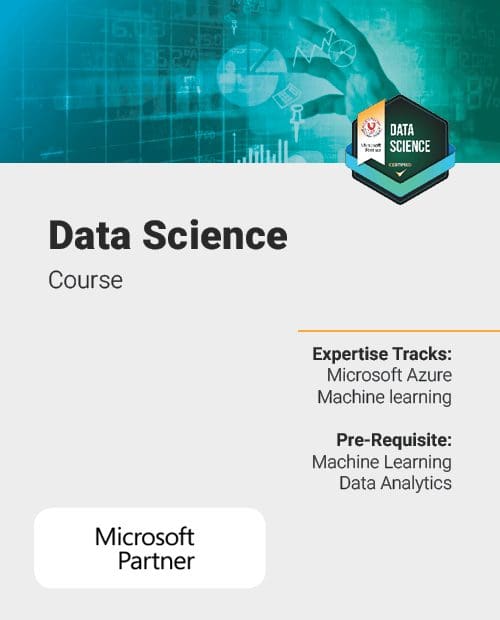
HOME REGISTER 46 HOURS ONLINE ENGLISH 46 HOURS ONLINE ENGLISH HOME REGISTER In this Data Science course, we will explore the vast field of machine learning leveraging the potential of Azure Machine Learning. Whether you’re building on your foundational knowledge of Python and machine learning or just getting started, this course will guide you through important aspects such as data ingestion, preparation, model training, and deployment. Plus, you’ll learn how to monitor machine learning solutions proficiently within the Microsoft Azure environment. It’s a course designed to give you the skills and knowledge to harness the full power of Azure in machine learning, helping you become proficient in data science. What You’ll Learn At the end of this course, learners will be able to describe what data science and machine learning are, including their applications & use cases, and the various types of tasks performed by data scientists. They will also be proficient in examining the Azure Machine Learning SDK tool. Furthermore, learners will be equipped to deploy, train, and analyze a model using Azure Machine Learning. Skills You’ll Gain Microsoft Azure Machine learning Roles Data Scientist AI Engineer What You’ll Learn At the end of this course, learners will be able to describe what data science and machine learning are, including their applications & use cases, and the various types of tasks performed by data scientists. They will also be proficient in examining the Azure Machine Learning SDK tool. Furthermore, learners will be equipped to deploy, train, and analyze a model using Azure Machine Learning. Skills You’ll Gain Microsoft Azure Machine learning Role Data Scientist AI Engineer Course Outline Module 1: Design a Machine Learning SolutionModule 2: Exploring Azure Machine LearningModule 3: Data Management in Azure MLModule 4: Working with Azure ML Compute ResourcesModule 5: No-Code Approaches in Azure MLModule 6: Automation in Model SelectionModule 7: Using Notebooks in Azure MLModule 8: Training Models using ScriptsModule 9: Optimization Techniques in Azure MLModule 10: Model Management TechniquesModule 11: Model Deployment and ConsumptionModule 12: Machine Learning Operations (MLOps) in Azure Required Resources Laptop, Intel Core i5 or higher, 16GB, 1TB Storage, Graphics Card (Hardware); Microsoft Azure (Software); Adequate Internet Connection (Network) Pre-Requisites This course is designed for data scientists with existing knowledge of Python and machine learning frameworks like Scikit-Learn, PyTorch, and Tensorflow, who want to build and operate machine learning solutions in the cloud. Assessment One (1) diagnostic assessment is available, conducted synchronously, and is knowledge-based, with the flexibility for learners to choose between remote or on-site participation. Two (2) formative assessments are offered, one focused on knowledge and the other on performance. Both are available asynchronously, allowing learners to complete them at their own pace, and learners have the option to participate remotely or on-site. A performance-based summative assessment is to be conducted synchronously, providing learners with the choice of remote or on-site participation. Credit and Recognition The learner is eligible to take the Microsoft Certified: Azure Data Scientist Associate. This course is facilitated by a Microsoft Certified professional. To ensure the quality of this micro-credential, continuous feedback loops with students, instructors, and industry practitioners are maintained to continually improve content, delivery, and assessment methods. Learning Pathways Data Science is the ultimate destination, and it can be reached through two distinct paths:Data Analytics: If you’re passionate about discovering actionable insights from data.Machine Learning: If you’re intrigued by the world of predictive modeling and artificial intelligence.
Data Engineering
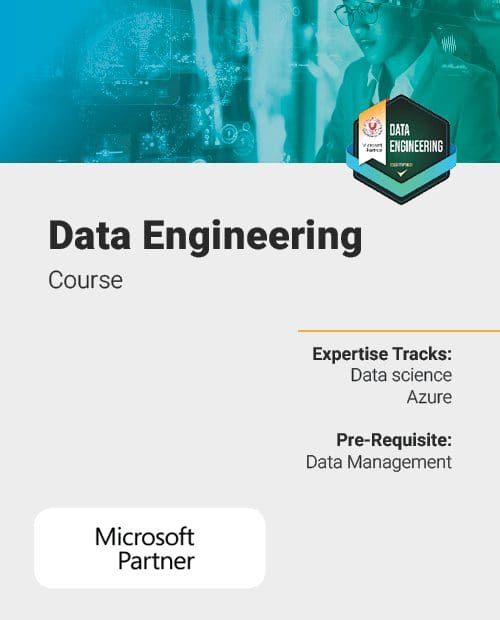
HOME REGISTER 32 HOURS ONLINE ENGLISH 65 HOURS ONLINE ENGLISH HOME REGISTER In this Data Engineering course, you will learn how to work with batch and real-time analytics solutions using the technology provided by the Azure data platform. The journey begins with understanding the core computing and storage technologies essential in building analytical solutions. You will discover how to explore data stored in data lakes interactively, using files as your guide. From there, we will cover the various techniques available for data ingestion using prominent tools such as Apache Spark in Azure Synapse Analytics or Azure Databricks, as well as Azure Data Factory or Azure Synapse pipelines. Not only will you learn how to bring data into your analytics systems, but you will also explore different methods to transform this data using the same ingestion tools. As we go further, we emphasize the critical role of security in protecting data whether it’s stored or being transferred. Towards the end, you will learn to create real-time analytics systems, opening doors to crafting solutions that work with data as it comes in, providing insights faster and more accurately. This course is designed to give you hands-on experience and a strong foundation in the fast-paced world of data engineering. What You’ll Learn At the end of this course, learners will be able to design and implement various stages and concepts in the data engineering lifecycle, including storage, processing, and security, in Microsoft Azure. Additionally, they will be capable of creating and performing data service operations, such as monitoring and optimization, in Microsoft Azure. Skills You’ll Gain Data science Azure Roles Data Engineer What You’ll Learn At the end of this course, learners will be able to design and implement various stages and concepts in the data engineering lifecycle, including storage, processing, and security, in Microsoft Azure. Additionally, they will be capable of creating and performing data service operations, such as monitoring and optimization, in Microsoft Azure. Skills You’ll Gain Data science Azure Role Data Engineer Course Outline Module 1: Get Started with Data Engineering on Azure Module 2: Build data analytics solutions using Azure Synapse serverless SQL pools Module 3: Perform data engineering with Azure Synapse Apache Spark Pools Module 4: Work with Data Warehouses using Azure Synapse Analytics Module 5: Transfer and transform data with Azure Synapse Analytics pipelines Module 6: Work with Hybrid Transactional and Analytical Processing Solutions using Azure Synapse Analytics Module 7: Implement a Data Streaming Solution with Azure Stream Analytics Module 8: Govern data across an enterprise Module 9: Data engineering with Azure Databricks Required Resources Laptop, Intel Core i5 or higher, 16GB, 1TB Storage, Graphics Card (Hardware); Microsoft Azure (Software); Adequate Internet Connection (Network) Pre-Requisites The primary audience for this course is data professionals, data architects, and business intelligence professionals who want to learn about data engineering and building analytical solutions using data platform technologies that exist on Microsoft Azure. The secondary audience for this course are data analysts and data scientists who work with analytical solutions built on Microsoft Azure. Assessment One (1) diagnostic assessment is available, conducted synchronously and is knowledge-based, with the flexibility for learners to choose between remote or on-site participation. Two (2) formative assessments are offered, one focused on knowledge and the other on performance. Both are available asynchronously, allowing learners to complete them at their own pace, and learners have the option to participate remotely or on-site. A performance-based summative assessment is to be conducted synchronously, providing learners with the choice of remote or on-site participation. Credit and Recognition The learner is eligible to take the Microsoft Certified: Azure Data Engineer Associate. This course is facilitated by a Microsoft Certified professional. To ensure the quality of this micro-credential, continuous feedback loops with students, instructors, and industry practitioners are maintained to continually improve content, delivery, and assessment methods. Learning Pathways Data Management is your prerequisite for entering the world of Data Engineering, where you’ll learn how to architect and manage data pipelines efficiently. Data Engineering is an essential step toward mastering Machine Learning.
Machine Learning

HOME REGISTER 19 HOURS ONLINE ENGLISH 19 HOURS ONLINE ENGLISH HOME REGISTER In this Machine Learning course, we will equip you with a strong foundation in the critical concepts and practical skills needed to work with classical machine learning models. The journey begins with understanding the core principles, supported by a healthy balance of theoretical knowledge and hands-on exercises to grasp various machine learning techniques and their practical applications. You’ll become adept at preprocessing and analyzing data, building resilient models, and evaluating their performance to make informed, data-driven decisions. Suitable for both beginners and those looking to build on their existing knowledge, this course aims to empower you with the competencies required to tackle real-world challenges effectively using classical machine learning models. What You’ll Learn At the end of this course, learners will be able to demonstrate a comprehensive understanding of the fundamental concepts, principles, and techniques of machine learning. They will also be equipped to apply their knowledge of machine learning to real-world scenarios. Furthermore, they will develop the ability to critically analyze and evaluate machine learning models, synthesize their knowledge and skills to construct and refine these models, and evaluate the effectiveness and performance of machine learning models. Skills You’ll Gain Microsoft Azure Machine learning Roles Data Scientist AI Engineer What You’ll Learn At the end of this course, learners will be able to demonstrate a comprehensive understanding of the fundamental concepts, principles, and techniques of machine learning. They will also be equipped to apply their knowledge of machine learning to real-world scenarios. Furthermore, they will develop the ability to critically analyze and evaluate machine learning models, synthesize their knowledge and skills to construct and refine these models, and evaluate the effectiveness and performance of machine learning models. Skills You’ll Gain Microsoft Azure Machine learning Role Data Scientist AI Engineer Course Outline Module 1: Introduction to Data for Machine LearningModule 2: Explore and Analyze Data with PythonModule 3: Train and Understand Regression Models in Machine LearningModule 4: Refine and Test Machine Learning ModelsModule 5: Train and Evaluate Regression ModelsModule 6: Create and Understand Classification Models in Machine LearningModule 7: Customize Architectures and Hyperparameters Using Random ForestModule 8: Confusion Matrix and Data ImbalancesModule 9: Optimize Model Performance with ROC and AUCModule 10: Train and Evaluate Classification ModelsModule 11: Train and Evaluate Clustering ModelsModule 12: Train and Evaluate Deep Learning Models Required Resources Laptop, Intel Core i5 or higher, 16GB, 1TB Storage, Graphics Card (Hardware); Microsoft Azure (Software); Adequate Internet Connection (Network) Pre-Requisites This course is designed for data scientists with existing knowledge of Python and machine learning frameworks like Scikit-Learn, PyTorch, and Tensorflow, who want to build and operate machine learning solutions in the cloud. Assessment In this Machine Learning course: One (1) diagnostic assessment is available, conducted synchronously, and is knowledge-based, with the flexibility for learners to choose between remote or on-site participation. Two (2) formative assessments are offered, one focused on knowledge and the other on performance. Both are available asynchronously, allowing learners to complete them at their own pace, and learners have the option to participate remotely or on-site. A performance-based summative assessment is to be conducted synchronously, providing learners with the choice of remote or on-site participation. Credit and Recognition Upon successful completion of the Machine Learning course, learners will receive a Certificate of Completion. This certificate serves both as a recognition of acquired expertise in machine learning and as a foundational step toward more advanced studies in the field of Data Science. This course is facilitated by a Microsoft Certified professional. To ensure the quality of this micro-credential, continuous feedback loops with students, instructors, and industry practitioners are maintained to continually improve content, delivery, and assessment methods. Learning Pathways Your journey into Machine Learning begins with either Data Engineering or Data Management. This foundational knowledge will equip you with the skills needed to explore the exciting field of Machine Learning, which, in turn, opens doors to the broader field of Data Science.
IoT – Internet of Things: Connecting Things
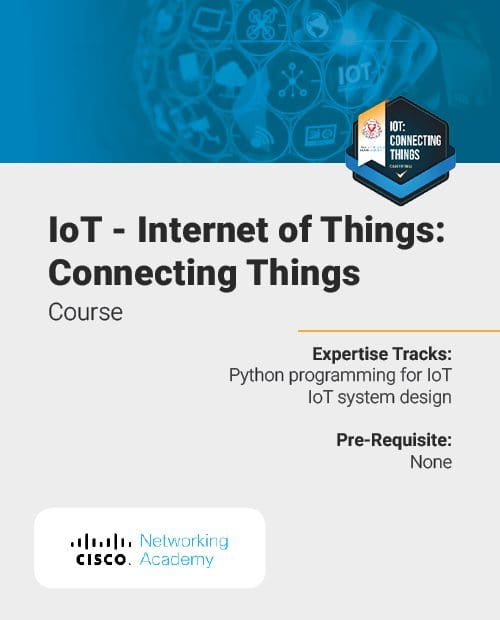
HOME REGISTER 20 HOURS HYBRID ENGLISH 20 HOURS HYBRID ENGLISH HOME REGISTER In the “IoT – Internet of Things: Connecting Things” course, you’ll dive deep into the fundamental concepts that drive the Internet of Things (IoT). You’ll start by exploring the core reasons behind the move to connect everything, identifying what exactly can be connected, and learning the strategies to establish this extensive connectivity. The journey will take you through the workings of a typical IoT solution which encompasses sensors, local analytic capabilities, network connections, and the skills to analyze the collected data effectively. You will learn to enhance products, processes, or businesses through detailed instrumentation and data collection, starting from an end-to-end connection from a sensor to a gateway, all the way to networks and the cloud. Moreover, the course guides you in pinpointing problems solvable by IoT and helps you design an IoT system precisely catered to solve those issues. It is a comprehensive approach to understanding and utilizing IoT in real-world scenarios. What You’ll Learn At the end of this course, learners will be able to design circuits and develop microcontroller programs using Arduino with various components. They will also be proficient in developing Python programs on the Raspberry Pi to enable IoT functionality. Additionally, learners will be adept at utilizing Packet Tracer to simulate Python-integrated IoT systems and will be equipped to construct business models using the Business Model Canvas. They will also understand the applications of IoT in sectors like healthcare, energy, smart-city, and manufacturing. Furthermore, learners will recognize the significance of designing secure IoT solutions that safeguard devices, software, and data. Skills You’ll Gain Python programming for IoT IoT system design Roles IoT Developer IoT Product Manager What You’ll Learn At the end of this course, learners will be able to design circuits and develop microcontroller programs using Arduino with various components. They will also be proficient in developing Python programs on the Raspberry Pi to enable IoT functionality. Additionally, learners will be adept at utilizing Packet Tracer to simulate Python-integrated IoT systems and will be equipped to construct business models using the Business Model Canvas. They will also understand the applications of IoT in sectors like healthcare, energy, smart-city, and manufacturing. Furthermore, learners will recognize the significance of designing secure IoT solutions that safeguard devices, software, and data. Skills You’ll Gain Python programming for IoT IoT system design Roles IoT Developer IoT Product Manage Course Outline Module 1: Things and Connections Module 2: Sensors, Actuators, and Microcontrollers Module 3: Software is Everywhere Module 4: Fog Networks and Cloud Services Module 5: Industrial IoT Applications Module 6: Create an IoT Solution Required Resources Microsoft Windows or Mac OS (Software); Prototyping Lab Application, Cisco Packet Tracer 7.1 or later (Software); Raspberry Pi 3 CanaKit Ultimate Starter Kit, Sparkfun Inventor’s Kit for Arduino – V3.2, Multicolored Jumper Wires (40-pin Male to Female, 40-pin Male-to-Male, 40-pin Female-to-Female), Breadboard Jumper Wires (Hardware). Pre-Requisites Basic Python programming skills and foundational knowledge in networking and electronics Assessment In this IoT: Big Data and Analytics course: One (1) diagnostic assessment is available, to be conducted synchronously and is knowledge-based, with the flexibility for learners to choose between remote or on-site participation. A performance-based summative assessment is to be conducted synchronously, offering learners the option of participating remotely or on-site. Two (2) formative assessments are offered, both concentrating on performance-based skills measurement and to be conducted synchronously. Learners have the option to participate remotely or on-site. Credit and Recognition This Fundamental Course is a stackable pre-requisite for the Hackathon Playbook and IoT Security, and the certification is globally recognized wherever Cisco and Cisco NetAcad are acknowledged. This course is delivered in partnership with CISCO Networking Academy. To ensure the quality of this micro-credential, continuous feedback loops with students, instructors, and industry practitioners are maintained to continually improve content, delivery, and assessment methods. Learning Pathways “IoT – Internet of Things: Connecting Things” requires prior completion of “IoT – Internet of Things: Big Data and Analytics.” This prerequisite ensures that you have the foundational knowledge needed for a smooth and successful progression in your IoT education.
Mastering GIS Basics with ArcGIS
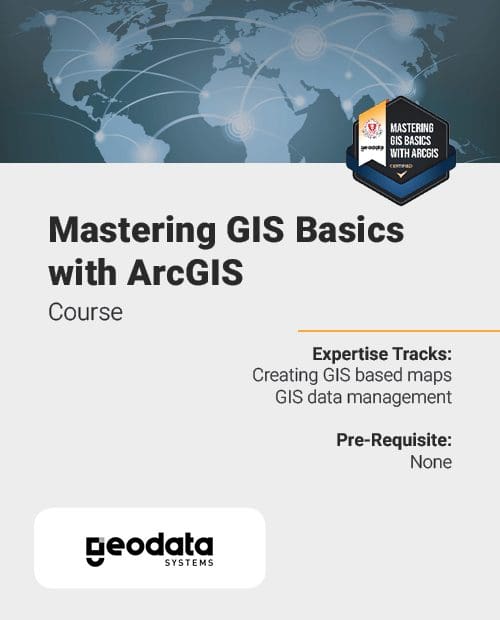
HOME REGISTER 24 HOURS FACE-TO-FACE ENGLISH In the Mastering GIS Basics with ArcGIS course, you will come to grips with the fundamental concepts of geographic data and GIS technology. This course is crafted to take you on a journey where you’ll learn how to use GIS maps to bring real-world features to your fingertips, enabling you to visualize and explore them in depth. But it doesn’t stop there; you’ll delve into data analysis to extract valuable insights and learn how to share these maps, data, and other vital resources across your organization. The course encapsulates essential workflows, tools, and techniques pivotal in GIS, offering you hands-on experience through practical exercises. By the end of this immersive learning experience, you will have honed the skills needed to navigate and utilize GIS technology effectively, ready to apply them in real-world scenarios. What You’ll Learn At the end of this course, learners will be able to manage spatial information by creating, updating, and organizing data using Geographic Information System (GIS) software. They will also be skilled in displaying features on a GIS map accurately and accessing its information efficiently. Additionally, learners will be adept at employing standard workflows to analyze GIS data and address spatial challenges. Furthermore, they will be equipped to design GIS map layouts and web maps to visualize data and disseminate analysis results. Skills You’ll Gain Creating GIS based maps GIS data management Roles GIS Technician Basic GIS User Course Outline Module 1: The Basics of GIS Module 2: Understanding Geographic Data Module 3: Visualizing Data Module 4: Labeling Features Module 5: Working with Tabular Data Module 6: Creating and Editing Data Module 7: Evaluating Data for Analysis Module 8: Solving Spatial Problems Module 9: Designing Map Layouts Module 10: Sharing Geographic Information Required Resources i-series or equivalent processor, 8GB RAM, 1GB video card, 500GB available hard disk, 15” monitor or dual display (Hardware); Windows 10 or higher (Software); Internet connection of speed 5 Mbps or faster (Network) Pre-Requisites At least a High School or Senior High School Graduate Assessment Practical Assessment: Hands-on activities are prepared for this course to assess the attainment of learning outcomes Final Assessment: This exam measures your ability to create, modify, and manage a structural project using Revit Structures Credit and Recognition This Basic GIS course is offered in collaboration with Geodata Systems Technologies, Inc., the exclusive Esri distributor in the Philippines, and is affiliated with certifying entities such as Logotri-Philnet of the Local Government Academy, the Civil Service Commission, and the Philippine Society for Training and Development (PSTD). It is stackable and serves as a prerequisite for the Advanced GIS Micro-credential Program. This course is in developed and delivered in collaboration with Geodata Systems Technologies, Inc. To ensure the quality of this micro-credential, continuous feedback loops with students, instructors, and industry practitioners are maintained to continually improve content, delivery, and assessment methods. Learning Pathways This course is the foundational cornerstone of your journey into the world of Geographic Information Systems (GIS). It equips you with the essential skills and knowledge required to grasp the basics of GIS, setting the stage for your exploration of more advanced GIS concepts and applications.
Cybersecurity: Cyber Threat Management
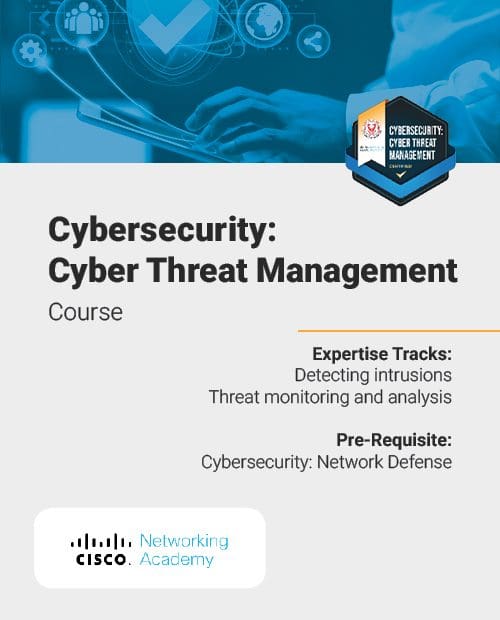
HOME REGISTER 32 HOURS HYBRID ENGLISH 32 HOURS HYBRID ENGLISH HOME REGISTER In the “Cybersecurity: Cyber Threat Management” course, you will dive into the fundamental concepts essential in the field of cybersecurity. We kick things off with ethics and governance before moving onto practical skills such as network security testing and endpoint vulnerability assessment. Throughout the course, we maintain a strong focus on critical aspects like threat intelligence and risk management, equipping you with the knowledge to respond effectively post-incident. Our goal is to prepare you to effectively engage in threat management and incident response activities, becoming a valuable member of a cybersecurity operations team. By the end of the course, you’ll have the skills and confidence to play a pivotal role in managing cyber threats, standing on the front lines of defense in the ever-vital field of cybersecurity. What You’ll Learn At the end of this course, learners will be able to use commands to gather network information and diagnose connectivity issues. They will also be proficient in explaining how endpoint vulnerabilities are assessed and managed. Furthermore, learners will be adept at evaluating security controls based on organization characteristics, and they will be equipped to apply various standards in incident handling procedures to a given incident scenario. Skills You’ll Gain Detecting intrusions Threat monitoring and analysis Roles IoT Developer IoT Project Manager What You’ll Learn At the end of this course, learners will be able to use commands to gather network information and diagnose connectivity issues. They will also be proficient in explaining how endpoint vulnerabilities are assessed and managed. Furthermore, learners will be adept at evaluating security controls based on organization characteristics, and they will be equipped to apply various standards in incident handling procedures to a given incident scenario. Skills You’ll Gain Detecting intrusions Threat monitoring and analysis Roles Cyber Security Analyst Course Outline Module 1: Governance and ComplianceModule 2: Security AssessmentsModule 3: Threat IntelligenceModule 4: Endpoint Vulnerability AssessmentModule 5: Risk Management and Security ControlsModule 6: Digital Forensics and Incident Analysis and Response Required Resources Computer, 2GB RAM or higher, 8GB free disk space (Hardware); Oracle VirtualBox, Virtual Machine Image File (Software); High-speed Internet Connection (Network) Pre-Requisites PC and internet navigation skills, basic Windows and Linux system concepts, and a basic understanding of computer network protocols, services, processes, and configurations; completed course Cybersecurity: Network Defense Assessment In this Cybersecurity: Cyber Threat Management course: One (1) diagnostic assessment is available, to be conducted asynchronously and will be knowledge-based, allowing learners to proceed at their own pace. It offers the flexibility for remote or on-site participation. Two (2) formative assessments are offered, one concentrating on knowledge and the other on performance-based skills measurement. Both formative assessments are to be conducted synchronously, giving learners the choice of participating remotely or on-site. A performance-based summative assessment is to be conducted synchronously, offering learners the option of remote or on-site participation. Credit and Recognition The certification is globally recognized wherever Cisco and Cisco NetAcad are acknowledged. The course is delivered in partnership with CISCO Networking Academy and aligns with CISCO-Certified Support Technician (CCST) Cybersecurity certification. To ensure the quality of this micro-credential, continuous feedback loops with students, instructors, and industry practitioners are maintained to continually improve content, delivery, and assessment methods. Learning Pathways Cybersecurity: Network Defense is a prerequisite for Cybersecurity: Cyber Threat Management. Upon successfully completing this course, you will have successfully completed the Junior Cybersecurity Analyst Pathway, equipping you with the skills and knowledge needed for a career in cybersecurity.
Data Analytics

HOME REGISTER 26 HOURS ONLINE ENGLISH 42 HOURS ONLINE ENGLISH HOME REGISTER In this Data Analytics course, you’ll dive deep into learning the best strategies and techniques for working with data using Power BI, a powerful tool that meets both business and technical needs. You’ll learn how to handle data from a range of sources, both relational and non-relational, and how to visualize and analyze that data to make informed decisions. We’ll also cover the essential skills needed to manage, deploy, and share reports and dashboards, promoting effective collaboration among teams. Whether you’re working with a business or on a technical project, this course equips you with the knowledge to leverage Power BI in optimizing data analysis and reporting processes. What You’ll Learn At the end of this course, learners will be able to prepare and organize data for analysis. They will also be equipped to develop analytical skills, encompassing data cleaning, analysis, and visualization, using Power BI. Furthermore, learners will be proficient in creating and managing workspaces and datasets in Power BI. Skills You’ll Gain Data analysis Azure Power BI Roles Data Analyst What You’ll Learn At the end of this course, learners will be able to prepare and organize data for analysis. They will also be equipped to develop analytical skills, encompassing data cleaning, analysis, and visualization, using Power BI. Furthermore, learners will be proficient in creating and managing workspaces and datasets in Power BI. Skills You’ll Gain Data analysis Azure Power BI Role Data Analyst Course Outline Module 1: Microsoft Data Analytics Module 2: Prepare Data for Analysis Module 3: Model Data in Power BI Module 4: Visualize Data in Power BI Module 5: Data Analysis in Power BI Module 6: Manage Workspaces and Datasets in Power BI Reqired Resources Laptop, Intel Core i5 or higher, 16GB, 1TB Storage, Graphics Card (Hardware); Microsoft Power BI (Software); Adequate Internet Connection (Network) Pre-Requisites The audience for this course are data professionals and business intelligence professionals who want to learn how to accurately perform data analysis using Power BI. This course is also targeted toward those individuals who develop reports that visualize data from the data platform technologies that exist both in the cloud and on-premises. Assessment In this Data Analytics course: One (1) diagnostic assessment is available, conducted synchronously, and focuses on knowledge-based testing. Learners have the flexibility to choose between remote or on-site participation. Two (2) formative assessments are offered, one concentrating on knowledge and the other on performance-based skills measurement. Both formative assessments are available asynchronously, allowing learners to complete them at their own pace, with the option of remote or on-site participation. A summative assessment in Data Analytics is centered on performance-based skills evaluation. This summative assessment is to be conducted synchronously, giving learners the choice of participating remotely or on-site. Credit and Recognition The learner is eligible to take the Microsoft Certified: Power BI Data Analyst Associate. This course is facilitated by a Microsoft Certified professional. To ensure the quality of this micro-credential, continuous feedback loops with students, instructors, and industry practitioners are maintained to continually improve content, delivery, and assessment methods. Learning Pathways Data Analytics Path: Data Management serves as your starting point on the path to becoming a skilled Data Analyst. This path ultimately leads to a broader understanding of data through Data Science.
Engineering
Home / Page Engineering The College of Engineering at Batangas State University, The National Engineering University (BatStateU The NEU), is a top engineering school in the Philippines, celebrated for producing globally competitive graduates and topnotchers. The college is a leader in engineering education, with a strong focus on innovation, sustainability, and nation-building, and it integrates technopreneurship into its curricula to equip students with 21st-century skills. Its Electronics Engineering program is a CHED-designated Center of Excellence, while its Electrical and Mechanical Engineering programs are recognized as Centers of Development. Furthermore, BatStateU is the first state university in the country to have multiple engineering programs, including Chemical, Civil, Computer, Electrical, Electronics, Industrial, Mechanical, and Sanitary Engineering, accredited by the US-based ABET, under both the Engineering Accreditation Commission (EAC) and the Philippine Technological Council’s ACBET. Programs Offered Undergraduate Programs Bachelor of Science in Chemical Engineering (BSChE) Bachelor of Science in Food Engineering (BSFE) Bachelor of Science in Ceramics Engineering (BSCerE) Bachelor of Science in Metallurgical Engineering (BSMetE) Bachelor of Science in Civil Engineering (BSCE) (with specializations in Construction Engineering Management, Geotechnical Engineering, Structural Engineering, Transportation Engineering, and Water Resources Engineering) Bachelor of Science in Sanitary Engineering (BSSE) Bachelor of Science in Geodetic Engineering (BSGE) Bachelor of Science in Geological Engineering (BSGeoE) Bachelor of Science in Transportation Systems Engineering (BSTE) Bachelor of Science in Electrical Engineering (BSEE) (with specializations in Machine Automation and Process Control and Renewable Energy for Sustainable Development) Bachelor of Science in Computer Engineering (BSCpE) Bachelor of Science in Electronics Engineering (BSECE) (with specializations in Computer Communication, Microelectronics, and Telecommunications and Building Infrastructures) Bachelor of Science in Instrumentation and Control Engineering (BSICE) Bachelor of Science in Mechatronics Engineering (BSMexE) Bachelor of Science in Aerospace Engineering (BSAeE) Bachelor of Science in Biomedical Engineering (BSBioE) Bachelor of Science in Industrial Engineering (BSIE) Bachelor of Science in Mechanical Engineering (BSME) Bachelor of Science in Petroleum Engineering (BSPetE) Bachelor of Science in Automotive Engineering (BSAE) Bachelor of Science in Naval Architecture and Marine Engineering (BSNAME) Graduate Programs Doctor of Philosophy in Electronics Engineering (PhDECE) Doctor of Philosophy in Engineering Education (PhDEEd) Doctor of Philosophy in Engineering Management (PhDEM) Master of Science in Artificial Intelligence (MSAI) Master of Science in Advanced Manufacturing (MSAM) Master of Science in Computer Engineering (M.S.CpE) Master of Science in Construction Management (MSCM) Master of Science in Earthquake Engineering (MSEaE) Master of Science in Electronics Engineering (M.S.ECE) Master of Science in Engineering Management (MSEM) Master of Science in Energy Engineering (MSEgyE) Master of Science in Material Science and Engineering (MSMSE) Master of Science in Transportation Systems Engineering (MSTE) Master of Engineering in Civil Engineering (M.Engg.CE) Master of Engineering in Chemical Engineering (M.Engg.ChE) Master of Engineering in Computer Engineering (M.Engg.CpE) Master of Engineering in Electrical Engineering (M.Engg.EE) Master of Engineering in Electronics Engineering (M.Engg.ECE) Master of Engineering in Environmental Engineering (M.Engg.EnE) Master of Engineering in Industrial Engineering (M.Engg.IE) Master of Engineering in Mechanical Engineering (M.Engg.ME) Straight Master’s to Doctorate in Electronics Engineering (SMD-ECE) Straight Bachelors to Masters in Electronics Engineering (SBM-ECE) BatStateU-Alangilan
College of Informatics and Computing Sciences
Alangilan Administration Students Faculty Research Extension Linkages Facilities Alangilan Administration Students Faculty Research Extension Linkages Facilities Home / Page College of Informatics and Computing Sciences The College of Informatics and Computing Sciences traces its origins back to 1990 when it was established as a department under the College of Arts and Sciences, led by Dr. Gloria Mendoza. Initially, the department offered a two-year Associate in Computer Science program, enrolling 24 students with four instructors. Of these, 12 graduated in 1992 and continued to pursue the Bachelor of Science in Computer Science, with the first batch graduating in 1994. Simultaneously, the College of Engineering, under the leadership of Engr. Jessie Montalbo began offering the Bachelor of Science in Computer Engineering program, with its first cohort of 30 students graduating in 1995. CICS Goal College of Informatics and Computing Sciences aims to shape globally competitive computer magnates as they develop their professional identities and ethical values. It establishes equanimity, objectivity and wisdom, unselfishness and concern for the environment through their technological competencies, community partnerships and strong faith in the Supreme Being. It promotes excellence in the pedagogy as it develops a well-rounded graduate who can assume dynamic leadership, meaningful participation and internalization initiatives in the field of Information Technology and Computing Sciences. Provide curricular programs for the development of a well-trained IT professionals, and Computer scientists. Advance ideals of national identity devoid of cultural biases, but enriched with moral integrity, spiritual vigor, and credible pursuit for professional excellence; Develop professional graduates ready for entry as active participants and/or competent leaders in the industrialized world who are: Well-educated in the principles of a particular discipline; Well-trained in the art and science of computer applications such as: productivity tools, authoring software and software development applications. Well-oriented in advocating national consciousness on the promotion of our history, culture and traditions. The College of Informatics and Computing Science shall: Inculcate the students the tent of ethical values that show traits of humility and compassion required of a well-rounded magnate fully equipped with critical thinking and sound moral judgment; Produce competitive graduates exercising academic freedom for life-long learning which is productive and value laden. Supply professional expertise in the application of a particular field suited to the needs of the nation in general, and the community and region in particular; Provide necessary solutions to the IT/CS problems related to the new ideas or existing ones like product development, service enhancement and environmental conservation and protection; Train students as leaders who would be specialists in the various fields of computer and information technology and inclined to provide the highest standards of research, extension service and production. Teach and encourage students to apply every principle to the notion of entrepreneurship that would promote the development of products, services and viable technology to tap the existing and unrealized potentials of the resources of the community, region and country. Program Educational Objectives The alumni of Bachelor of Science in Computer Science and Bachelor of Science in Information Technology programs, about three to five years after graduation shall: Help create innovations to ensure the competitive edge of the Philippine computing industry. Adhere to ethical standards in the practice of the computing profession. Student Outcomes Bachelor of Science in Computer Science Ability to analyze complex computingproblems and to apply principles ofcomputing and other relevant disciplines toidentify solutions. Ability to design, implement, and evaluate computing-based solutions to meet a given set of computing requirements in the context of the program’s discipline. Ability to communicate effectively in a variety of professional contexts. Ability to recognize professional responsibilities and make informed judgments in computing practice based on legal and ethical principles. Ability to function effectively as a member or leader of a team engaged in activities appropriate to the program’s discipline. Ability to apply computer science theory and software development fundamentals to produce computing-based solutions. Bachelor of Science in Information Technology Ability to analyze complex computing problems and to apply principles of computing and other relevant disciplines to identify solutions. Ability to design, implement, and evaluate computing-based solutions to meet a given set of computing requirements in the context of the program’s discipline. Ability to communicate effectively in a variety of professional contexts. Ability to recognize professional responsibilities and make informed judgments in computing practice based on legal and ethical principles. Ability to function effectively as a member or leader of a team engaged in activities appropriate to the program’s discipline. Use systemic approaches to select, develop, apply, integrate, and administer secure computing technologies to accomplish user goals. College History College Figures Accreditation Curriculum In 1997, the College of Computer Studies was formally established, with Engr. Jessie Montalbo is serving as its first dean. The newly formed college incorporated the BS Computer Science program from the College of Arts and Sciences and the BS Computer Engineering program from the College of Engineering. That same year, the college launched the BS Information Management program, followed by BS Information Technology in 1998, and BS Computer Education in 1999. The most recent addition to the college’s offerings is the BS in Library Information Management, introduced in the current academic year. With the expanding list of programs came a corresponding growth in student enrollment, faculty members, and the development of modern laboratories, student services offices, and research and development facilities. In 2000, the university established the IT Center to manage its IT applications, as well as the Informatics and Computing Sciences Center, which oversees the college’s research and extension services. Engr. Rolando M. Lontok Jr., the current Associate Dean of the College, was appointed to supervise both centers. That same year, the college began providing internet access for its students and faculty. In recognition of the increasing importance of information and communication technologies, the College of Computer Studies was renamed the School of Informatics and Computing Sciences in mid-2000. In 2007, the school was merged with the College of Engineering, Architecture, and Fine Arts to form the College of Engineering, Architecture, Fine Arts, and Computing Sciences (CEAFACS). Informatics

